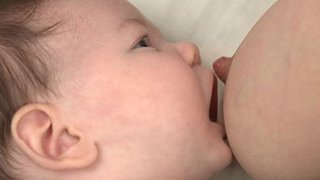Latching on
Latching on is how your baby attaches to your breast to feed. Lots of people assume that this comes naturally, but in reality it's more of a skill that you and your baby need to learn together.
Good attachment also helps prevent sore and cracked nipples, so it's important to get it right.
Knowing it's time to feed
If possible, try to feed your baby when you are both relaxed and comfortable.
Your baby will let you know they are hungry by doing things like:
- sucking their fists
- licking their lips
- wriggling and opening their mouths, as if they're searching for your breast
Encourage your baby to feed fully from each breast. This will help them get the fattier milk that comes towards the end of the feed.
Step-by-step guide to latching on
This guide shows you how to latch your baby onto your breast in 4 steps.

1. Hold your baby's whole body close with their nose level with your nipple.

2. Let your baby's head tip back a little so that their top lip can brush against your nipple. This should help your baby to make a wide, open mouth.

3. When your baby's mouth opens wide, their chin should be able to touch your breast first, with their head tipped back so that their tongue can reach as much breast as possible.

4. With your baby's chin firmly touching your breast and their nose clear, their mouth should be wide open. You should see much more of the darker nipple skin above your baby's top lip than below their bottom lip. Your baby's cheeks will look full and rounded as they feed.
Video: Latching on animation
This animated breastfeeding video shows you how to get a good latch with your baby.
Frequency of feeds
Your newborn will want to breastfeed frequently throughout the day and night.
It might seem as though you're feeding them all the time, but this is totally normal. As they get better (and more efficient) at feeding, they'll need to do it less often.
Let your baby guide you as to how often and how long they should feed. Do not worry about feeding your baby too often – it's impossible to breastfeed your baby too much.
Newborns tend to breastfeed at least 8 times a day (24 hours) for the first few weeks. And your baby may want to feed more and for longer at night – that's because this is when you produce more prolactin (the hormone that produces milk).
If you find that your nipples are sore, have a look at our advice and tips on how to soothe sore nipples.
Cluster feeding
Cluster feeding usually happens during the first 3 to 4 months. It's when your baby wants to feed even more frequently, sometimes constantly, over a period of time.
It's very normal and nothing to be concerned about.
Your baby may want to cluster feed during the day or night, or a bit of both. Your baby may cluster feed for a few days when they're going through a growth spurt, but once your supply catches up with demand, things should be back to normal.

Breastfeeding Friend from Start for Life
The Breastfeeding Friend, a digital tool from Start for Life, has lots of useful information and expert advice to share with you – and because it's a digital tool, you can access it 24/7.
Help and support
For confidential breastfeeding information and support, call the National Breastfeeding Helpline on 0300 100 0212.
Lines are open 9:30am to 9:30pm every day.